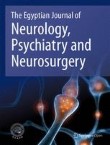The Egyptian Society of Neurology, Psychiatry and Neurosurgery
Psychopathology of antisocial personality disorder: from the structural, functional and biochemical perspectives
Antisocial personality disorder (ASPD) is characterized by a lack of empathy, a sense of guiltlessness and shamelessness, as well as impulsiveness. ASPD is a relatively common psychiatric condition in the gene...

